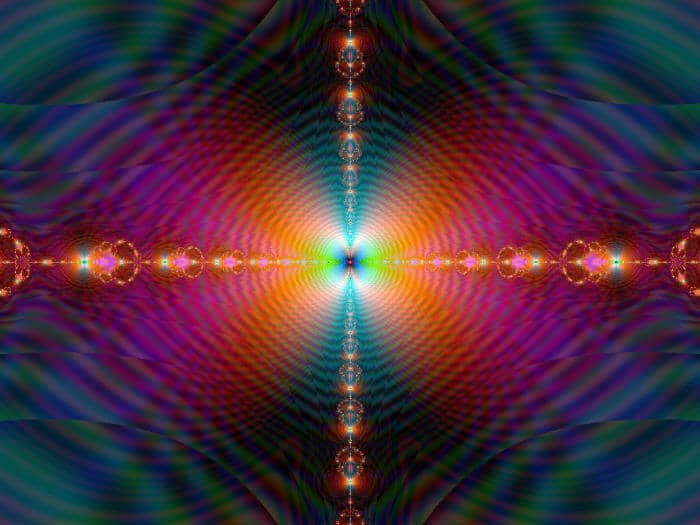
In English, the word Adamantine means “something extremely hard, unyielding,” in fact, “adamant.” This word derivates from the Latin word Adamantus. It is also an adjective to qualify something as “hard and brilliant as a diamond.”
The Adamantine Particles form all Elements of the Universe. They are the smallest, indivisible particles that assemble the atoms of all original substances like oxygen, nitrogen, iron; in other words, “everything that is”, including our bodies.
Quantum Mechanics has discovered deeper layers of structure in ordinary matter. Matter is composed, on a tiny scale, of particles called atoms. Atoms are in turn made up of a very small nucleus surrounded by a cloud of particles called electrons. The nucleus is made of particles called protons and neutrons, which are themselves made up of even smaller particles called quarks.
In the following paragraphs you will find a brief and easy introduction that will assist you understanding this relatively new science. Before we begin, we must realize that no one has ever seen an atom or any subatomic particle, not even using the most powerful electronic microscopes. Quantum physicists have proven most of their theories by observing and studying the behavior of subatomic particles. In fact, Quantum Physics is just a theory.
We believe that quantum physicists have already proven the existence of adamantine particles; however, they have given different names to these fundamental particles, some of the names are: electrons, quarks, muons, neutrinos, etc. this happens due to the fact that some of these scientists are based in different countries and are funded by diverse organizations.
In order to avoid creating confusion, in the Adamantine System we use the metaphysical name of Adamantine Particles to label all fundamental particles.
Scientists of the early 20th century found they could not explain the behavior of atoms using their current knowledge of traditional physics. Therefore, scientists developed a new interpretation of matter and energy to describe atoms. They formulated the Quantum Theory, or quantum mechanics. The quantum theory describes matter as acting both as a particle and as a wave. In the visible objects encountered in everyday life, the wavelike nature of matter is too small to be apparent. Wavelike nature becomes important, however, in microscopic particles such as electrons, which behave like waves. They exist as a fuzzy cloud of negative charge around the nucleus, instead of as a particle located at a specific point.
The words “Adamantine Particles” are used for the first time in English in Glenda Green’s book “Love without End” published in 1998. However, the word “Adamantine” has been around for thousands of years.
In the Buddhist tradition we can find one of the first references to this word; in Sanskrit “Vajra” means Adamantine, and “Vajradhatu” is a Sanskrit word which means “adamantine sphere”. But perhaps, the most important finding was that the word “Vajrasattva” means “the Adamantine Being” who represents the Buddha of purification and healing.
The Vajrasattva Meditation is a special practice recommended by Vajrayana Buddhism to their practitioners who wish to cleanse themselves from impurities accumulated and caused by negative feelings, thoughts, words and actions.
In English the word Adamantine means “something extremely hard or unyielding”, in fact “adamant.” It is also an adjective to qualify something as “hard and brilliant as a diamond”. The term particle is used in the context of subatomic particles, thus adamantine particles are subatomic in size and nature.
The Adamantine particles form all elements of the Universe; in other words, they are the smallest indivisible particles that assemble the atoms of all original substances like oxygen, nitrogen, iron; therefore, all that is, including our bodies.
We can say that “Adamantine particles” mean “pure particles”, not combined with anything; particles so pure, small and simple that cannot be divided and therefore are, and represent, an “absolute”. They are one of the constants of the universe.
Adamantine particles are fundamental particles of matter and energy that are not yet properly identified by scientists; most probably, quantum physicists have already discovered these particles and have named them differently; it is also quite possible that our current scientific approach does not allow them to fully understand its characteristics.
Adamantine particles are crystal-like particles of infinity, which contain stored potential to manifest any original substance or element. It can also be said that adamantine particles are encoded with a kind of “universal DNA” that allows them to form any possible type of atom.
Adamantine particles require “power” to build the other particles and atoms. There is, however, only one type of energy (not energy generated by friction as we know in 3D) that is compatible with them. This energy is the magnetic power of Love, which pervades the Universe in the form of Universal Life Force. Love is not only the most beautiful feeling, it also is the power which ignites and directs adamantine particles into manifestation.
We can also call Love and its magnetic power, Potential; pure and infinite potential to command the adamantine particles to form infinite numbers of forms of expression of such potential. Love is the ultimate force in the Universe; it holds every galaxy, star and planet in its place. In the presence of Love, patterns of beauty, perfection, harmony and efficiency manifest spontaneously.
source:
http://www.gayleparker.com/Pages/AdamantineParticles.aspx
++ Planck Field: Material World & Consciousness ~ Nassim Haramein